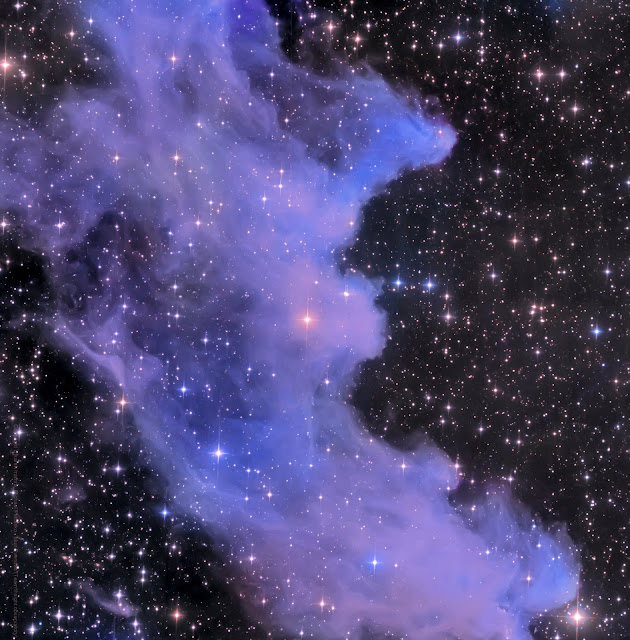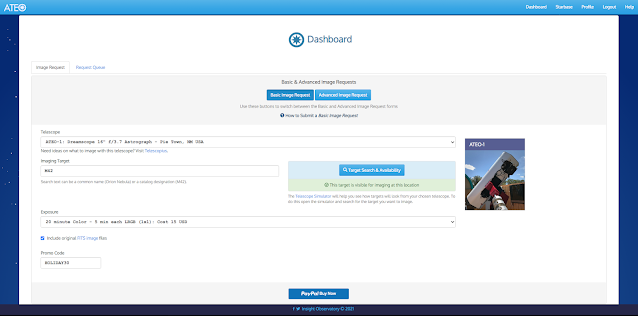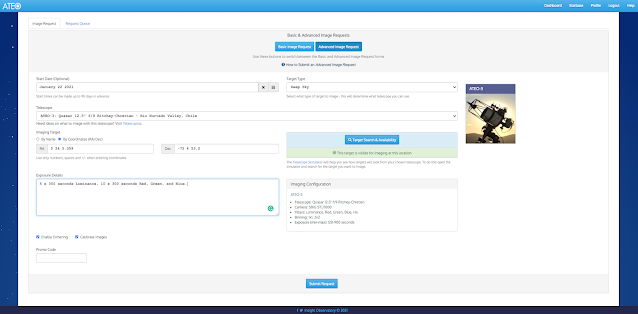In appreciation for all of the recent support, Insight Observatory has received from its users and patrons, nearly 5-hours of LRGB complimentary image data of NGC 1909 (IC 2118) - The Witch Head Nebula has been added free of charge to Starbase, Insight Observatory's image set repository. This image data was acquired on the 16" f/3.75 Dream Aerospace Systems astrograph reflector (ATEO-1) remote telescope hosted at SkyPi Remote Observatory located in the dark skies of New Mexico.
Some facts about NGC 1909:
NGC 1909 (IC 2118 - also known as Witch Head Nebula due to its shape) is an extremely faint reflection nebula believed to be a supernova remnant or a gas cloud illuminated by nearby supergiant star Rigel in the constellation of Orion. It lies in the Orion constellation, about 900 light-years from Earth. The nature of the dust particles, reflecting blue light better than red, is a factor in giving the Witch Head its blue color.
Radio observations show substantial carbon monoxide emission throughout parts of NGC 1909, an indicator of the presence of molecular clouds and star formation in the nebula. In fact, candidates for pre-main sequence stars and some classic T-Tauri stars have been found deep within the nebula.
The molecular clouds of NGC 1909 are probably placed closely together to the outer boundaries of the vast Orion-Eridanus bubble, a giant supershell of molecular hydrogen blown by the high-mass stars of the Orion OB1 association. As the supershell expands into the interstellar medium, favorable circumstances for star formation occur. NGC 1909 is located in one such area. The windblown appearance and cometary shape of the bright reflection nebula are highly suggestive of a strong association with the high-mass luminous stars of Orion OB1. The fact that the heads of the cometary clouds of NGC 1909 point northeast towards the association are a strong support of that relationship.
Source: Wikipedia
To access these image frames, please log into Starbase using your ATEO Portal credentials. The image set is labeled "NGC1909 - LRGB (2020): Witch Head Nebula" and can be quickly located by doing a search for NGC1909 in the name field on the Starbase dashboard. You will notice that the image set is marked in green color as "Public" in the subscription column to the right. This designates the image set as subscribed to for everyone and the download of the image data is free of charge. This Offer is for a LIMITED TIME ONLY and expires on 03-31-2021.
Read More
Some facts about NGC 1909:
NGC 1909 (IC 2118 - also known as Witch Head Nebula due to its shape) is an extremely faint reflection nebula believed to be a supernova remnant or a gas cloud illuminated by nearby supergiant star Rigel in the constellation of Orion. It lies in the Orion constellation, about 900 light-years from Earth. The nature of the dust particles, reflecting blue light better than red, is a factor in giving the Witch Head its blue color.
Radio observations show substantial carbon monoxide emission throughout parts of NGC 1909, an indicator of the presence of molecular clouds and star formation in the nebula. In fact, candidates for pre-main sequence stars and some classic T-Tauri stars have been found deep within the nebula.
 |
| ATEO-1: 16" Dream astrograph reflector with an image of M63 - The Sunflower Galaxy imaged by Utkarsh Mishra and Gamma Observatory that houses ATEO-1 at SkyPi Remote Observatory. |
The molecular clouds of NGC 1909 are probably placed closely together to the outer boundaries of the vast Orion-Eridanus bubble, a giant supershell of molecular hydrogen blown by the high-mass stars of the Orion OB1 association. As the supershell expands into the interstellar medium, favorable circumstances for star formation occur. NGC 1909 is located in one such area. The windblown appearance and cometary shape of the bright reflection nebula are highly suggestive of a strong association with the high-mass luminous stars of Orion OB1. The fact that the heads of the cometary clouds of NGC 1909 point northeast towards the association are a strong support of that relationship.
Source: Wikipedia
To access these image frames, please log into Starbase using your ATEO Portal credentials. The image set is labeled "NGC1909 - LRGB (2020): Witch Head Nebula" and can be quickly located by doing a search for NGC1909 in the name field on the Starbase dashboard. You will notice that the image set is marked in green color as "Public" in the subscription column to the right. This designates the image set as subscribed to for everyone and the download of the image data is free of charge. This Offer is for a LIMITED TIME ONLY and expires on 03-31-2021.








